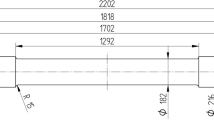Abstract
The paper reports the results of theoretical and experimental tests of a forming process for producing ball studs which are widely used in the automotive industry. It is proposed that semi-finished ball studs are produced by cross wedge rolling in a double configuration. The theoretical analysis was performed by numerical techniques based on the finite element method. Numerical computations were made using the simulation software DEFORM v 11.0. During the simulations, the accuracy of the adopted tool design was verified, and optimal parameters of the process along with the effect of selected parameters of the process and the quality of produced parts were determined. The proposed rolling process was verified under laboratory conditions using a flat-wedge forging machine available at the Lublin University of Technology. The experimental findings show a high agreement with the numerical results, in terms of both quality and quantity. The results confirm that ball studs can be produced by the proposed cross wedge rolling technique.
Similar content being viewed by others
Reference
C. Weiss, M.M. Morlock, N.P. Hoffmann, Friction induced dynamics of ball joints: instability and post bifurcation behavior, European Journal of Mechanics A/Solids 45 (2014) 161–173.
P. Alexandru, I. Visa, C. Alexandru, Modeling the angular capability of the ball joints in a complex mechanism with two degrees of mobility, Applied Mathematical Modelling 38 (2014) 5456–5470.
J.G. Eom, Y.H. Son, S.W. Jeong, et al., Effect of strain hardening capability on plastic deformation behaviors of material during metal forming, Materials and Design 54 (2014) 1010–1018.
J.H. Song, Y.T. Im, Expert system for the process sequence design of a ball stud, Journal of Material Processing Technology 89–90 (1999) 72–78.
Z. Gronostajski, M. Hawryluk, M. Kaszuba, et al., Die profile optimization for forging constant velocity joint casings, Archives of Metallurgy and Materials 56 (2011) 551–558.
Z. Gronostajski, M. Hawryluk, The main aspects of precision forging, Archives of Civil and Mechanical Engineering 8 (2008) 39–55.
C.S. Im, S.R. Suh, M.C. Lee, et al., Computer aided process design in cold-former forging using a forging simulator and a commercial CAD software, Journal of Materials Processing Technology 95 (1999) 155–163.
W.S. Weroński, A. Gontarz, Z. Pater, The research of forging process of eccentric part on three slide forging press, Journal of Materials Processing Technology 177 (2006) 214–217.
G. Winiarski, A. Gontarz, Z. Pater, A new process for the forming of a triangular flange in hollow shafts from Ti6Al4V alloy, Archives of Civil and Mechanical Engineering 15 (2015) 911–916.
B. Heißing, M. Ersoy, Chassis Handbook. Fundamentals, Driving Dynamics, Components, Mechatronics, Perspectives, Deutsche Nationalbibliothek, Berlin, 2011.
http://www.afdex.com [accessed 15.03.16].
J. Zhou, Y. Yu, Q. Zeng, Analysis and experimental studies of internal voids in multi-wedge cross wedge rolling stepped shaft, International Journal of Advanced Manufacturing Technology 72 (2014) 1559–1566.
H. Ji, J. Li, B. Wang, et al., Cross-wedge rolling of a 4Cr9Si2 hollow valve: explorative experiment and finite element simulation, International Journal of Advanced Manufacturing Technology 77 (2015) 15–26.
J. Tomczak, Z. Pater, T. Bulzak, The influence of hollow billet thickness in rotary compression, International Journal of Advanced Manufacturing Technology 82 (2016) 1281–1291.
J. Zhao, L.Q. Lu, Z.H. Hu, Study on varying rule of mechanical parameters in forming automobile semi-axes with multiwedge cross wedge rolling, Proceedings of the International Conference on Mechanical Engineering and Mechanics 1–2 (2007) 1723–1727.
W. Yuan, L. Wang, T. Yuan, Experimental study on cross wedge rolling process of aluminum alloy material, in: 5th International Conference on Advanced Engineering Materials and Technology 5 (AEMT 2015), 2015, 415–422.
Z. Pater, A. Tofil, J. Tomczak, T. Bulzak, Numerical analysis of the cross wedge rolling process (CWR) for a stepped shaft, Metalurgija 54 (2015) 177–180.
J. Tomczak, Z. Pater, T. Bulzak, Thermo-mechanical analysis of a lever preform forming from magnesium alloy AZ31, Archives of Metallurgy and Materials 57 (2012) 1211–1218.
Z. Pater, Analysis of the helical-wedge rolling process for producing a long stepped shaft, Key Engineering Materials 622–623 (2014) 893–898.
Author information
Authors and Affiliations
Corresponding author
Rights and permissions
About this article
Cite this article
Bulzak, T., Pater, Z. & Tomczak, J. Numerical and experimental analysis of a cross wedge rolling process for producing ball studs. Archiv.Civ.Mech.Eng 17, 729–737 (2017). https://doi.org/10.1016/j.acme.2017.02.002
Received:
Accepted:
Published:
Issue Date:
DOI: https://doi.org/10.1016/j.acme.2017.02.002



